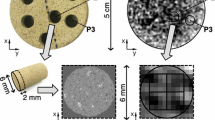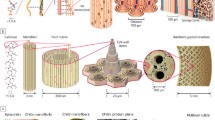Abstract
Macroscopic mechanical properties of materials depend directly on their microstructure. Microscopy, and more specifically tomography, is a key method for studying microstructures. Here, we propose a simple way to use an X-ray tomogram to infer local elastic properties. We distinguish between two scenarios of microstructure images. In the first scenario, the material is composed by very apparent phases so the image can be easily segmented into a set of subspaces with homogenous properties. In the second scenario, the image, as that of sedimentary rocks, contains poorly contrasted phases, including strong intra-phase heterogeneities. For this case, we propose an alternative to segmentation techniques in order to factor in material heterogeneities. To do this, we use the local X-ray attenuation to define elastic moduli. Then, we compute up-scaled elastic moduli by solving the mechanical equilibrium. Finally, we confirm our method by comparing the up-scaled elastic moduli to indentation experiments performed at the same scale.





Similar content being viewed by others
References
Haralick RM, Shapiro LG (1985) Image segmentation techniques. Comput Gr Image Process 29(1):100–132
Arbelaez P, Maire M, Fowlkes C (2011) Contour detection and hierarchical image segmentation. J Malik IEEE Trans PAMI 33(5):898–916
Lalaouia L, Mohamadib T, Djaalab A (2015) New method for image segmentation. Proc Soc Behav Sci 195:1971–1980
Bossa N, Chaurand P, Vicente J, Borschneck D, Levard C, Aguerre-Chariol O, Rose J (2015) Micro- and nano-x-ray computed-tomography: a step forward in the characterization of the pore network of a leached cement paste. Cem Concr Res 67:138–147
Hubler MH, Gelb J, Ulm F-J (2017) Microtexture analysis of gas shale by XRM imaging. J Nanomech Micromech 7(3):04017005
Houben ME, Desbois G, Urai JL (2014) A comparative study of representative 2D microstructures in shaly and sandy facies of opalinus clay (Mont Terri, Switzerland) inferred form BIB-SEM and MIP methods. Mar Pet Geol 49:143–161
Saif T, Lin Q, Bijeljic B, Blunt MJ (2017) Microstructural imaging and characterization of oil shale before and after pyrolysis. Fuel 197:562–574
Hackley PC, Cardott BJ (2016) Application of organic petrography in North American shale petroleum systems: a review. Int J Coal Geol 163:8–51
Agrawal A (2009) A technical and economic study of completion techniques in five emerging U.S. gas shale plays. Thesis, Texas A&M University
Phillips DH, Lannutti JJ (1997) Measuring physical density with x-ray computed tomography. NDT E Int 30(6):339–350
Kucuk N, Tumsavas Z, Cakir M (2013) Determining photon energy absorption parameters for different soil samples. J Radiat Res 54(3):578–586
Obliger A, Valdenaire P-L, Capit N, Ulm FJ, Pellenq RJ-M, Leyssale J-M (2018) Poroelasticity of methane-loaded mature and immature kerogen from molecular simulations. Langmuir 34(45):13766–13780
Pellenq RJ-M, Lequeux N, van Damme H (2008) Engineering the bonding scheme in C–S–H: the iono-covalent framework. Cem Concr Res 38:159–174
Mavko G, Mukerji T, Dvorkin J (2009) The rock physics handbook, 2nd edn. Cambridge University Press, Cambridge
Sato H, Ono K, Johnston CT, Yamagishi A (2005) First-principles studies on the elastic constants of a 1:1 layered kaolinite mineral. Am Mineral 90:1824–1826
Ashby M, Shercliff H, Cebon D (2013) Materials: engineering, science, processing and design, 3rd edn. University of Cambridge, Cambridge
Farag MM (2014) Materials and process selection for engineering design, 3rd edn. Taylor & Francis, London
Zargari S, Prasad M, Mba KC, Mattson ED (2013) Organic maturity elastic properties, and textural characteristics of self resourcing reservoirs. Geophysics 78(4):D223–D235
Moulinec H, Suquet P (1995) A fft-based numerical method for computing the mechanical properties of composites from images of their microstructures. IUTAM Symp Microstruct Prop Interact Compos Mater 37:235–246
Moulinec H, Suquet P (1998) A numerical method for computing the overall response of nonlinear composites with complex microstructure. Comput Methods Appl Mech Eng 157(1–2):69–94
Valdenaire P-L (2016) Crystal plasticity - transport equation and dislocation density. Ph.D. Thesis, Mines ParisTech
Schneider M, Ospald F, Kabel M (2016) Computational homogenization of elasticity on a staggered grid. J Mech Phys Solids 105(9):693–720
Galin LA (1961) Contact problems in theory of elasticity. In: Sneddon IN (ed) Translated by Moss H, North Carolina State College
Sneddon IN (1965) The relation between load and penetration in the axi-symmetric Boussinesq problem for a punch of arbitrary profile. Int J Eng Sci 3:47–57
Laubie H, Monfareda S, Radjaï F, Pellenq RJ-M, Ulm F-J (2017) Disorder-induced stiffness degradation of highly disordered porous materials. J Mech Phys Solids 106:207–228
Laubie H, Radjai F, Pellenq R, Ulm F-J (2017) Stress transmission and failure in disordered porous media. Phys Rev Lett 119:075501
Acknowledgements
Financial support was provided by foundation AMU. The authors also thank Carl Zeiss X-ray microscopy for generously conducting the imaging work at their facilities. P.-L. Valdenaire thanks Shell Game Changer program for support.
Author information
Authors and Affiliations
Corresponding author
Additional information
Publisher's Note
Springer Nature remains neutral with regard to jurisdictional claims in published maps and institutional affiliations.
Rights and permissions
About this article
Cite this article
Valdenaire, PL., Perrin, J., Grauby, O. et al. A simple way to use X-ray micro-tomography to infer elastic properties of heterogeneous materials: application to sedimentary rocks. J Mater Sci 55, 3347–3353 (2020). https://doi.org/10.1007/s10853-019-04241-w
Received:
Accepted:
Published:
Issue Date:
DOI: https://doi.org/10.1007/s10853-019-04241-w




